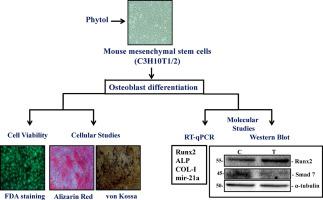当前位置:
X-MOL 学术
›
Bioorg. Med. Chem. Lett.
›
论文详情
Our official English website, www.x-mol.net, welcomes your
feedback! (Note: you will need to create a separate account there.)
An osteoinductive effect of phytol on mouse mesenchymal stem cells (C3H10T1/2) towards osteoblasts.
Bioorganic & Medicinal Chemistry Letters ( IF 2.5 ) Pub Date : 2020-03-24 , DOI: 10.1016/j.bmcl.2020.127137 Ganesh Sanjeev 1 , D Saleth Sidharthan 1 , S Pranavkrishna 1 , S Pranavadithya 1 , R Abhinandan 1 , R L Akshaya 1 , K Balagangadharan 1 , Nishitha Siddabathuni 1 , Swathi Srinivasan 1 , N Selvamurugan 1
Bioorganic & Medicinal Chemistry Letters ( IF 2.5 ) Pub Date : 2020-03-24 , DOI: 10.1016/j.bmcl.2020.127137 Ganesh Sanjeev 1 , D Saleth Sidharthan 1 , S Pranavkrishna 1 , S Pranavadithya 1 , R Abhinandan 1 , R L Akshaya 1 , K Balagangadharan 1 , Nishitha Siddabathuni 1 , Swathi Srinivasan 1 , N Selvamurugan 1
Affiliation

|
In recent years, phytochemicals have been widely researched and utilized for the treatment of various medical conditions such as cancer, cardiovascular diseases, age-related problems and are also said to have bone regenerative effects. In this study, phytol (3,7,11,15-tetramethylhexadec-2-en-1-ol), an acyclic unsaturated diterpene alcohol and a secondary metabolite derived from aromatic plants was investigated for its effect on osteogenesis. Phytol was found to be nontoxic in mouse mesenchymal stem cells (C3H10T1/2). At the cellular level, phytol-treatment promoted osteoblast differentiation, as seen by the increased calcium deposits. At the molecular level, phytol-treatment stimulated the expression of Runx2 (a bone-related transcription factor) and other osteogenic marker genes. MicroRNAs (miRNAs) play an essential role in controlling bone metabolism by targeting genes at the post-transcriptional level. Upon phytol-treatment in C3H10T1/2 cells, mir-21a and Smad7 levels were increased and decreased, respectively. It was previously reported that mir-21a targets Smad7 (an antagonist of TGF-beta1 signaling) and thus, protects Runx2 from its degradation. Thus, based on our results, we suggest that phytol-treatment promoted osteoblast differentiation in C3H10T1/2 cells via Runx2 due to downregulation of Smad7 by mir-21a. Henceforth, phytol was identified to bolster osteoblast differentiation, which in turn may be used for bone regeneration.
中文翻译:

植醇对成骨细胞对小鼠间充质干细胞(C3H10T1 / 2)的骨诱导作用。
近年来,植物化学物质已被广泛研究并用于治疗各种医学病症,例如癌症,心血管疾病,与年龄有关的问题,并且据说还具有骨再生作用。在这项研究中,研究了植物醇(3,7,11,15-四甲基十六烷基-2-烯-1-醇),无环不饱和二萜醇和衍生自芳香植物的次生代谢物对成骨的影响。已发现植物醇对小鼠间充质干细胞(C3H10T1 / 2)无毒。在细胞水平上,植醇处理促进成骨细胞分化,如钙沉积增加所见。在分子水平上,植醇处理刺激Runx2(与骨相关的转录因子)和其他成骨标记基因的表达。MicroRNA(miRNA)通过在转录后水平靶向基因,在控制骨代谢中起着至关重要的作用。在C3H10T1 / 2细胞中进行植醇处理后,mir-21a和Smad7的水平分别升高和降低。以前有报道说mir-21a靶向Smad7(TGF-β1信号转导的拮抗剂),因此保护Runx2免受其降解。因此,基于我们的结果,我们认为由于mir-21a对Smad7的下调作用,植酸处理通过Runx2促进了C3H10T1 / 2细胞的成骨细胞分化。从此以后,已确定植醇可促进成骨细胞分化,进而可用于骨再生。以前有报道说mir-21a靶向Smad7(TGF-β1信号转导的拮抗剂),因此保护Runx2免受其降解。因此,基于我们的结果,我们认为由于mir-21a对Smad7的下调作用,植酸处理通过Runx2促进了C3H10T1 / 2细胞的成骨细胞分化。从此以后,已确定植醇可促进成骨细胞分化,进而可用于骨再生。以前有报道说mir-21a靶向Smad7(TGF-β1信号转导的拮抗剂),因此保护Runx2免受其降解。因此,基于我们的结果,我们认为由于mir-21a对Smad7的下调作用,植酸处理通过Runx2促进了C3H10T1 / 2细胞的成骨细胞分化。从此以后,已确定植醇可促进成骨细胞分化,进而可用于骨再生。
更新日期:2020-04-20
中文翻译:

植醇对成骨细胞对小鼠间充质干细胞(C3H10T1 / 2)的骨诱导作用。
近年来,植物化学物质已被广泛研究并用于治疗各种医学病症,例如癌症,心血管疾病,与年龄有关的问题,并且据说还具有骨再生作用。在这项研究中,研究了植物醇(3,7,11,15-四甲基十六烷基-2-烯-1-醇),无环不饱和二萜醇和衍生自芳香植物的次生代谢物对成骨的影响。已发现植物醇对小鼠间充质干细胞(C3H10T1 / 2)无毒。在细胞水平上,植醇处理促进成骨细胞分化,如钙沉积增加所见。在分子水平上,植醇处理刺激Runx2(与骨相关的转录因子)和其他成骨标记基因的表达。MicroRNA(miRNA)通过在转录后水平靶向基因,在控制骨代谢中起着至关重要的作用。在C3H10T1 / 2细胞中进行植醇处理后,mir-21a和Smad7的水平分别升高和降低。以前有报道说mir-21a靶向Smad7(TGF-β1信号转导的拮抗剂),因此保护Runx2免受其降解。因此,基于我们的结果,我们认为由于mir-21a对Smad7的下调作用,植酸处理通过Runx2促进了C3H10T1 / 2细胞的成骨细胞分化。从此以后,已确定植醇可促进成骨细胞分化,进而可用于骨再生。以前有报道说mir-21a靶向Smad7(TGF-β1信号转导的拮抗剂),因此保护Runx2免受其降解。因此,基于我们的结果,我们认为由于mir-21a对Smad7的下调作用,植酸处理通过Runx2促进了C3H10T1 / 2细胞的成骨细胞分化。从此以后,已确定植醇可促进成骨细胞分化,进而可用于骨再生。以前有报道说mir-21a靶向Smad7(TGF-β1信号转导的拮抗剂),因此保护Runx2免受其降解。因此,基于我们的结果,我们认为由于mir-21a对Smad7的下调作用,植酸处理通过Runx2促进了C3H10T1 / 2细胞的成骨细胞分化。从此以后,已确定植醇可促进成骨细胞分化,进而可用于骨再生。











































 京公网安备 11010802027423号
京公网安备 11010802027423号